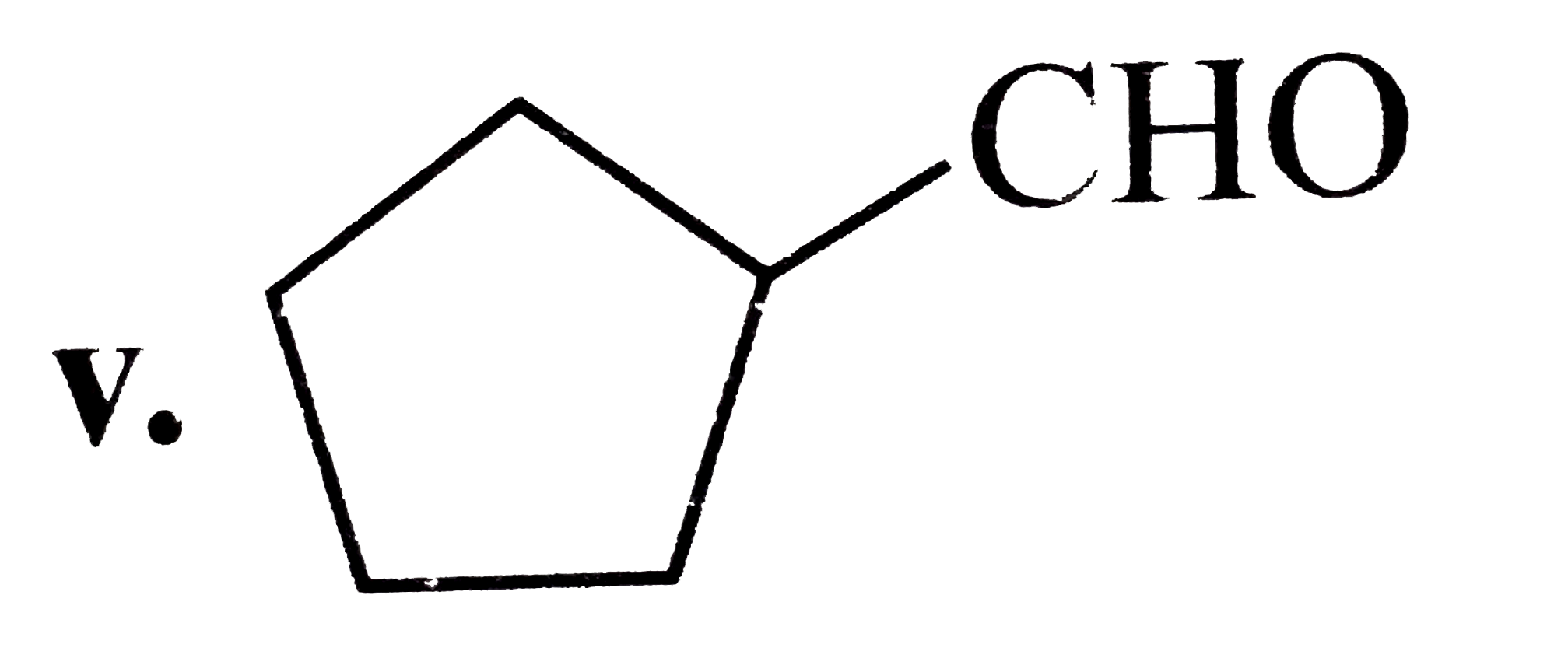Write the IUPAC names of the following ketones and aldehydes. Wherever possible, give also common names.
CH3(CH2)5CHO
To determine the IUPAC name of the compound CH₃(CH₂)₅CHO, we will follow these steps:
Step 1: Identify the Functional Group
The given compound has the functional group CHO, which indicates that it is an aldehyde.
Step 2: Count the Number of Carbon Atoms
Next, we will count the total number of carbon atoms in the compound:
- The structure is CH₃(CH₂)₅CHO.
- The CH₃ group contributes 1 carbon.
- The (CH₂)₅ group contributes 5 carbons.
- The CHO group contributes 1 carbon.
So, the total number of carbon atoms is:
1 (from CH₃) + 5 (from CH₂ groups) + 1 (from CHO) = 7 carbons.
Step 3: Determine the Longest Carbon Chain
The longest continuous carbon chain in the compound consists of 7 carbon atoms. Therefore, the base name will be derived from "heptane" since there are 7 carbons.
Step 4: Number the Carbon Chain
In aldehydes, the carbonyl group (C=O) is always at the end of the carbon chain. Therefore, we number the carbon chain starting from the end closest to the aldehyde group:
- The carbon chain can be numbered as follows:
1. CHO (1)
2. CH₂ (2)
3. CH₂ (3)
4. CH₂ (4)
5. CH₂ (5)
6. CH₂ (6)
7. CH₃ (7)
Step 5: Assign the IUPAC Name
Since the aldehyde group is at the first carbon, we use the suffix "-al" for aldehydes. Thus, the IUPAC name is:
- Heptanal
Step 6: Common Name (if applicable)
For aldehydes, common names are often derived from the corresponding carboxylic acids. However, "heptanal" does not have a widely recognized common name like some shorter aldehydes do. Therefore, we will stick with the IUPAC name.
Final Answer
The IUPAC name of the compound CH₃(CH₂)₅CHO is heptanal.
---
The given compound has the functional group CHO, which indicates that it is an aldehyde.
Next, we will count the total number of carbon atoms in the compound:
- The structure is CH₃(CH₂)₅CHO.
- The CH₃ group contributes 1 carbon.
- The (CH₂)₅ group contributes 5 carbons.
- The CHO group contributes 1 carbon.
1 (from CH₃) + 5 (from CH₂ groups) + 1 (from CHO) = 7 carbons.
The longest continuous carbon chain in the compound consists of 7 carbon atoms. Therefore, the base name will be derived from "heptane" since there are 7 carbons.
In aldehydes, the carbonyl group (C=O) is always at the end of the carbon chain. Therefore, we number the carbon chain starting from the end closest to the aldehyde group:
- The carbon chain can be numbered as follows:
1. CHO (1)
2. CH₂ (2)
3. CH₂ (3)
4. CH₂ (4)
5. CH₂ (5)
6. CH₂ (6)
7. CH₃ (7)
Since the aldehyde group is at the first carbon, we use the suffix "-al" for aldehydes. Thus, the IUPAC name is:
- Heptanal
For aldehydes, common names are often derived from the corresponding carboxylic acids. However, "heptanal" does not have a widely recognized common name like some shorter aldehydes do. Therefore, we will stick with the IUPAC name.
The IUPAC name of the compound CH₃(CH₂)₅CHO is heptanal.
Topper's Solved these Questions
- ALDEHYDES, KETONES AND CARBOXYLIC ACIDSBOOK - ICSECHAPTER - ALDEHYDES, KETONES AND CARBOXYLIC ACIDSEXERCISE - ISC EXAMINATION QUESTIONS (PART-II DESCRIPTIVE QUESTIONS) (CARBOXYLIC ACIDS)
99 Videos
- ALCOHOLS, PHENOLS AND ETHERS BOOK - ICSECHAPTER - ALCOHOLS, PHENOLS AND ETHERS EXERCISE - ISC EXAMINATION QUESTIONS
25 Videos
- APPENDIX II ( TYPICAL CONVERSIONS)BOOK - ICSECHAPTER - APPENDIX II ( TYPICAL CONVERSIONS)EXERCISE - AROMATIC CONVERSIONS
98 Videos
Similar Questions
Write the IUPAC names of the following ketones and aldehydes. Wherever possible, give also common names.
CH3CO(CH2)4CH3
View SolutionWrite the IUPAC names of the following ketones and aldehydes. Wherever possible, give also common names.
CH3CO(CH2)4CH3
View SolutionWrite the IUPAC names of the following ketones and aldehydes. Wherever possible, give also common names.
CH3CO(CH2)4CH3
View SolutionWrite the IUPAC names of following ketones and aldehydes. Wherever possible, give common nemes also.
i. CH3CO(CH2)4CH3
ii. CH3CH2CHBrCH2CH(CH3)CHO
iii. CH3(CH2)5CHO
iv. Ph−CH=CH−CHO
v.
vi. PhCOPh
View SolutionWrite the IUPAC names of the following ketones and aldehydes. Wherever possible, give also common names.
CH3CH2CHBrCH2CH(CH3)CHO
View SolutionWrite the IUPAC names of the following ketones and aldehydes. Wherever possible, give also common names.
CH3CH2CHBrCH2CH(CH3)CHO
View SolutionWrite the IUPAC names of the following ketones and aldehydes. Wherever possible, give also common names.
PhCOPh
View SolutionWrite the IUPAC names of the following ketones and aldehydes. Wherever possible, give also common names.
PhCOPh
View SolutionWrite the IUPAC names of the following ketones and aldehydes. Wherever possible, give also common names.
PhCOPh
View SolutionWrite the IUPAC names of the following ketones and aldehydes. Wherever possible, give also common names.
Ph−CH=CH−CHO
View Solution
